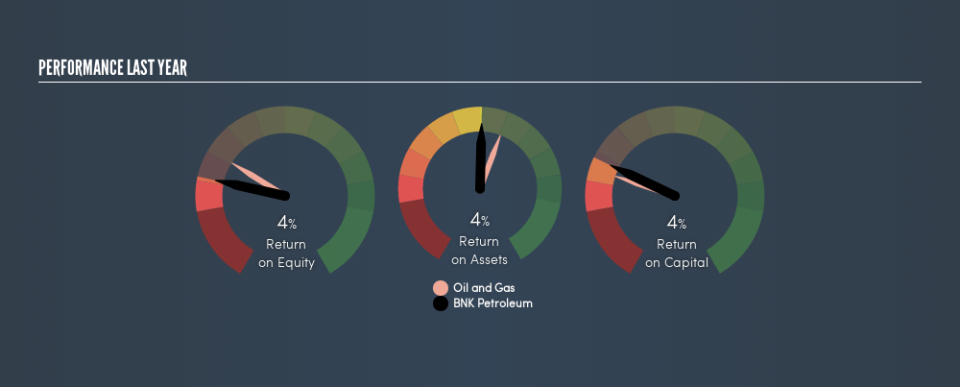Is BNK Petroleum Inc. (TSE:BKX) Struggling With Its 4.3% Return On Capital Employed?

Want to participate in a short research study? Help shape the future of investing tools and you could win a $250 gift card!
Today we'll evaluate BNK Petroleum Inc. (TSE:BKX) to determine whether it could have potential as an investment idea. Specifically, we'll consider its Return On Capital Employed (ROCE), since that will give us an insight into how efficiently the business can generate profits from the capital it requires.
First up, we'll look at what ROCE is and how we calculate it. Next, we'll compare it to others in its industry. And finally, we'll look at how its current liabilities are impacting its ROCE.
Return On Capital Employed (ROCE): What is it?
ROCE measures the amount of pre-tax profits a company can generate from the capital employed in its business. Generally speaking a higher ROCE is better. In brief, it is a useful tool, but it is not without drawbacks. Author Edwin Whiting says to be careful when comparing the ROCE of different businesses, since 'No two businesses are exactly alike.'
How Do You Calculate Return On Capital Employed?
Analysts use this formula to calculate return on capital employed:
Return on Capital Employed = Earnings Before Interest and Tax (EBIT) ÷ (Total Assets - Current Liabilities)
Or for BNK Petroleum:
0.043 = US$6.6m ÷ (US$163m - US$7.6m) (Based on the trailing twelve months to March 2019.)
So, BNK Petroleum has an ROCE of 4.3%.
See our latest analysis for BNK Petroleum
Is BNK Petroleum's ROCE Good?
ROCE can be useful when making comparisons, such as between similar companies. Using our data, BNK Petroleum's ROCE appears to be significantly below the 5.5% average in the Oil and Gas industry. This performance is not ideal, as it suggests the company may not be deploying its capital as effectively as some competitors. Regardless of how BNK Petroleum stacks up against its industry, its ROCE in absolute terms is quite low (especially compared to a bank account). There are potentially more appealing investments elsewhere.
In our analysis, BNK Petroleum's ROCE appears to be 4.3%, compared to 3 years ago, when its ROCE was 3.4%. This makes us think about whether the company has been reinvesting shrewdly.
When considering ROCE, bear in mind that it reflects the past and does not necessarily predict the future. ROCE can be deceptive for cyclical businesses, as returns can look incredible in boom times, and terribly low in downturns. ROCE is only a point-in-time measure. We note BNK Petroleum could be considered a cyclical business. If BNK Petroleum is cyclical, it could make sense to check out this free graph of past earnings, revenue and cash flow.
BNK Petroleum's Current Liabilities And Their Impact On Its ROCE
Short term (or current) liabilities, are things like supplier invoices, overdrafts, or tax bills that need to be paid within 12 months. Due to the way ROCE is calculated, a high level of current liabilities makes a company look as though it has less capital employed, and thus can (sometimes unfairly) boost the ROCE. To counteract this, we check if a company has high current liabilities, relative to its total assets.
BNK Petroleum has total assets of US$163m and current liabilities of US$7.6m. Therefore its current liabilities are equivalent to approximately 4.7% of its total assets. With barely any current liabilities, there is minimal impact on BNK Petroleum's admittedly low ROCE.
What We Can Learn From BNK Petroleum's ROCE
Nevertheless, there are potentially more attractive companies to invest in. Of course, you might find a fantastic investment by looking at a few good candidates. So take a peek at this free list of companies with modest (or no) debt, trading on a P/E below 20.
I will like BNK Petroleum better if I see some big insider buys. While we wait, check out this free list of growing companies with considerable, recent, insider buying.
We aim to bring you long-term focused research analysis driven by fundamental data. Note that our analysis may not factor in the latest price-sensitive company announcements or qualitative material.
If you spot an error that warrants correction, please contact the editor at editorial-team@simplywallst.com. This article by Simply Wall St is general in nature. It does not constitute a recommendation to buy or sell any stock, and does not take account of your objectives, or your financial situation. Simply Wall St has no position in the stocks mentioned. Thank you for reading.

 Yahoo Finance
Yahoo Finance 
